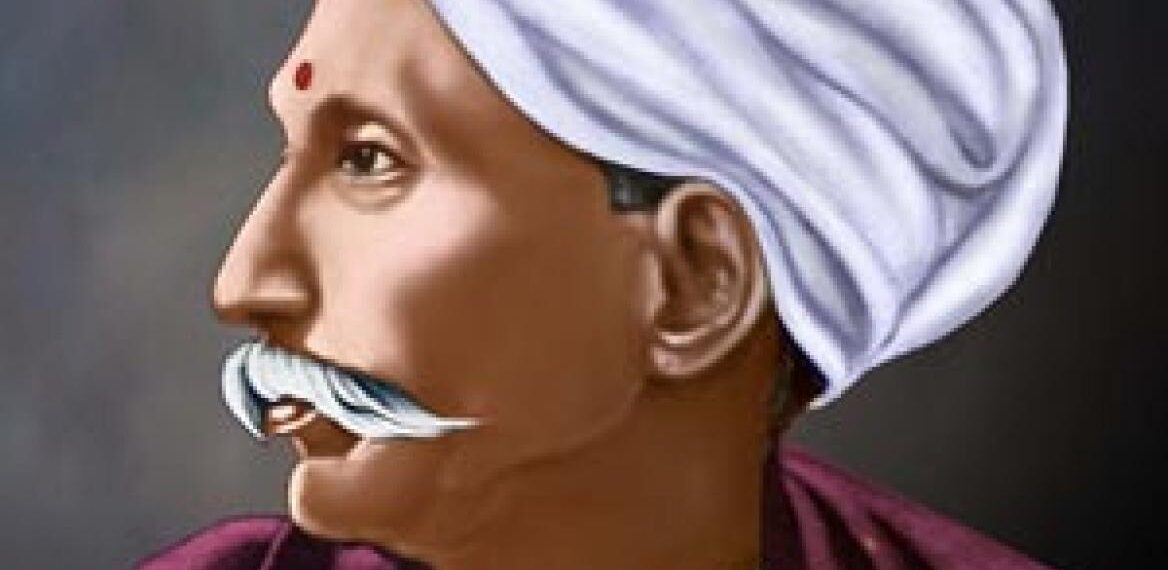Gurajada Venkata Apparao also called as ‘Gurajada’ was a social reformer and liberal thinker. He is also considered as the pathfinder of modernism in Telugu literature. Through his works, he strongly criticised social evils such as child marriage and dowry. He was a strong advocate for Women’s education and empowerment. He was posthumously awarded the Padma Bhushan, India’s third-highest civilian award, in 1954.
Gurajada Venkata Apparao was a remarkable literary figure in the late 19th and early 20th centuries, acclaimed for his eloquent contribution to liberal ideas in literature. He was born on September 21, 1862, in Rayavaram village of Visakhapatnam District. Gurajada is regarded as a modernist pioneer in Telugu literature. Kanyasulkam is the first Telugu drama written entirely in spoken dialect. Even after a century of publication, the prose play Kanyasulkam, written in the Visakhapatnam dialect, remains popular. In 1892, Gurajada’s acclaimed drama “Kanyasulkam” was staged for the general public. His other works include ‘Kukku’, an English poem (1882), ‘Sarangadhara’ an English poem (1883), ‘Kondubhattiyam’ (1906), ‘Neelagiri paatalu’ (1907), ‘Mutyalasaramulu’, ‘Kasulu'(1910), ‘Bilhaniyam’, ‘Lavana Rajula Kala'(1911), ‘Kanyaka’ (1912), ‘Subhadra'(1913), ‘Dinchu Langaru'(1914) and ‘Langarettumu'(1915).
Through his works, Apparao challenged the authoritarian and orthodox beliefs deeply ingrained in Indian society and culture. As a pioneer of liberal ideas, he advocated for individual freedom, rational thinking, and empowerment of women and marginalised communities. His exposition of social hindrances and his progressive stance on prevalent social issues made him a revolutionary figure in the literary scene of his era. His works testify to art’s capacity to inspire social change and oppose repressive ideologies.
By emphasising individual freedom and progressive values, Apparao consistently encouraged the conception that individuals have the right to live according to their beliefs and desires, free from social prejudices. His works are often linked with themes such as personal autonomy, the pursuit of happiness, and challenging traditional norms and values.
Kanyasulkam is the price paid by the bridegroom to the bride’s family in exchange for the girl in marriage. Kanyasulkam was an evil practice that perpetuated treating women as commodities to be bought and sold. It also forced women into unwanted marriages and relationships. Apparao’s patron, Maharaja Ananda Gajapati of Vizianagaram, was gathering information on child weddings a decade before Gurajada wrote the play, with the purpose of saving the unfortunate segment of womankind from a galling type of social demoralisation. This heinous tradition pricked the heart of Maharaja Ananda Gajapati. As a member of the Madras Legislative Council, Ananda Gajapati proposed a bill to prevent such marriages; nevertheless, the Committee rejected the bill, and he was unable to bring out the necessary legislation to restrict this social scourge.
Gurajada created Kanyasulkam drama with Maharaja Ananda Gajapati’s encouragement. The drama depicts not just Kanyasulkam practice but also corruption, language reform, widow remarriages, child marriages, and prostitution. He used humour to deal with sensitive topics of that age. He dedicated Kanyasulkam drama to Maharaja Ananda Gajapati, who, as a liberal thinker of his time, was deeply worried about societal problems and evils.
Kanyasulkam drama centres around Lubdhavadhanulu, an elderly, scholarly, thrifty, and widowed man of means. He is manipulated into a remarriage by a shrewd mediator Ramappa Pantulu, who seeks personal gain. Lubdhavadhanulu’s union is arranged with the 10-year-old Subbi, the younger daughter of the determined yet scholarly Agnihotravadhanulu, who intends to marry off his son using the money.
Subbi’s uncle Karataka Sastry devises a plan to save her from this marriage. He disguises his student Mahesam as the bride and himself as the bride’s father. Thwarting the alliance with Subbi, Lubhdhavadhanulu is lured into marriage with the disguised student Mahesam.
As the story unfolds, Kartaka Sastry’s insistence on a gold ornament during the wedding causes tensions between Lubdhavadhanulu and Ramappa Pantulu. The latter borrows a gold ornament from Madhuravani, his mistress, to stop the cancellation of the marriage. Kartaka Sastry then performs a rushed, one-night marriage and later escapes from the scene with the Kanyasulkam money. He instructs Mahesam to escape from the scene. After Mahesam escapes, Lubdhavadhanulu is accused of murder.
Amid the confusion, Lubdhavadhanulu is accused of murder when the bride disappears, leading to a legal battle. Madhuravani reveals the truth to the lawyer Soujanya Rao Pantulu, saving Lubdhavadhanulu from a grim fate. The play poignantly exposes the societal pressures, deceptions, and gender-related struggles during its time, weaving a compelling narrative that remains relevant in exploring timeless human complexities.
Coming to the characters and themes of the play, each character is significant since each reflects a distinct social reality of that period. Agnihotravadhanlu, Venkatesham, Girisham, and Madhuravani are the main characters of the play. Especially characters of Girisam and Madhuravani are the finest characters in Telugu Literature which stand for foolishness, immorality, sarcasm, and incongruity.
Girisam can be considered as the main protagonist of the play, if not a hero who represents so-called modernity, western ethos, and embodiment of crookedness with his command over English and philosophy. Readers often regard his character as “a pest, an enemy within”, “evil product of the alliance between traditional and modern social orders on the one hand and patriarchy on the other”. Gurajada created this character to shed light on the plight of the young widows at the hands of exploitative men. Posing as a reformer, Girisam abuses young widows and prostitutes. But Girisam, with all his flaws, is a loveable negative character, much like Mr. Jingle of The Pickwick Papers by Charles Dickens. Probably, Girisam represents the generation of social reformers who have internalised the progressive outlook but not solutions.
Another main character of the play is Madhuravani. Born into the family of Devadasis, she is a young, beautiful, and charming woman of 22 years. As a prostitute, her character depicts issues such as the morality of occupation, righteousness, and courage to speak up for oneself. Her dialogues represent dilemma and skepticism about the social reform activity of that time. She displays intelligence and liberal thinking, and as the play progresses, her actions contribute to conflict resolution. Madhuravani challenges traditional gender roles and expectations.
Gurajada Venkata Apparao’s legacy as a liberal thinker shines through his unwavering commitment to progressive thought. A literary luminary of his time, he wrote stories that dismantled the chains of convention. Through Kanyasulkam, he ignited a fire of belief in the audience and illuminated a path towards a liberated and equitable society.
References
- Rao, V. N. (2011). The indigenous modernity of Gurajada Apparao and Fakir Mohan Senapati. In Palgrave Macmillan US eBooks (pp. 135–152). https://doi.org/10.1057/9780230118348_6
- Srilatha, G., & Siddhartha, P. B. (2018). Language and Culture in Kanyasulkam. International Journal for Research in Engineering Application & Management.
Previous musing: FIGHTING FOR FREEDOM : THE TUMULTUOUS LEGACY OF RAGHUNATH KARVE


